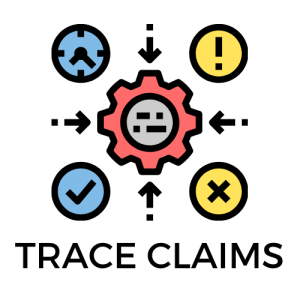7.2 Find Better Coverage AND Trace Claims Back to the Original Source
 The next step in the SIFT process is to Find Better Coverage. This step involves determining the credibility of a specific claim or piece of evidence from the source. In your preliminary evaluation you may have determined that the author’s credibility is appropriate and that the source is representing a balanced point of view (or at least you are aware of the source’s stand if not completely balanced). Now you need to determine if individual claims or evidence are accurate and contextually appropriate. Lateral reading is still helpful with these steps. Here are specific elements to look for to do this:
The next step in the SIFT process is to Find Better Coverage. This step involves determining the credibility of a specific claim or piece of evidence from the source. In your preliminary evaluation you may have determined that the author’s credibility is appropriate and that the source is representing a balanced point of view (or at least you are aware of the source’s stand if not completely balanced). Now you need to determine if individual claims or evidence are accurate and contextually appropriate. Lateral reading is still helpful with these steps. Here are specific elements to look for to do this:
Credibility of the content
Does the source provide citations or attribute information to a particular source or person? If so, follow that citation back to the original source to verify the claim. If not, Google the quote or claim to find more about it. In many cases you’ll come up with websites that are either discrediting or supporting the information as accurate. Fact checking websites and hoax busting websites are also good sources to consult. Below are 3 fact checking websites.
- PolitiFact “…is a fact-checking website that rates the accuracy of claims by elected officials and others.”
- factcheck.org“…is a nonpartisan, nonprofit ‘consumer advocate’ for voters that aims to reduce the level of deception and confusion in U.S. politics.”
- Snopes is…“The definitive Internet reference source for urban legends, folklore, myths, rumors, and misinformation.”
Website domain endings
Domain endings are part of the URL of a web address. Review the table to learn about common domain endings.
| Domain ending | Description |
|---|---|
| .gov | Websites with this domain are from U.S. government agencies like CDC.gov, EPA.gov. Government websites can be excellent sources of information for finding statistics, laws, etc. For example, to find demographic information check out census.gov. |
| .edu | Websites with this domain are from U.S. educational institutions. For example, scottsdalecc.edu, asu.edu. Many universities are research institutions and make their research available on their websites. These are great sources to consult. For example if you are researching poverty issues check out UC Davis Center for Poverty Research. |
| .com | Websites with this domain can be purchased and published by anyone, anywhere in the world. The dot com domain ending traditionally stands for commercial, but these websites can have many purposes. |
| .org | Websites with this domain can be purchased and published by anyone, anywhere in the world. The dot org traditionally stands for organization and many non-profits and other groups do tend to use this domain, however, non-profit or group status does NOT indicate a bias-free, fact-based provider of information. In fact, many non-profit groups have explicit or underlying agendas that influence the information they share or produce. |
Date of information
This element is a small but significant detail when determining the accuracy of claims or information because, well, things change over time. If someone’s claim is using out of date information as evidence, their claim can be weakened if not completely deflated.
Check out the Evaluating Evidence video from CrashCourse for more information on verifying claims and information.
Trace Claims Back to the Original Source

In the last step of the SIFT process, you will trace the claim or evidence back to the primary source (if possible). Primary, also meaning first, are sources where information originated. Primary sources can be:
- Data from research studies or experiments (helpful for determining if claims using statistics are accurate).
- Government documents (also helpful for finding data, statistics, laws, legislation, etc).
- Quotes, tweets, or posts from famous people or politicians (helpful for verifying if that screenshot of someone’s Twitter account is real or fabricated).
- Images (it is important to note that it is very easy for images online to be manipulated, photoshopped, or used out of context.
Check out the video, Search the History of an Image, below to learn how to verify the original image and its context)
SIFT Source Analysis Tool
Download the SIFT Source Analysis Tool document to help you analyze and evaluate websites, news articles, and claims you read online.
You can also find more information, tips and tools on the TCC Library’s Media Literacy Guide.

